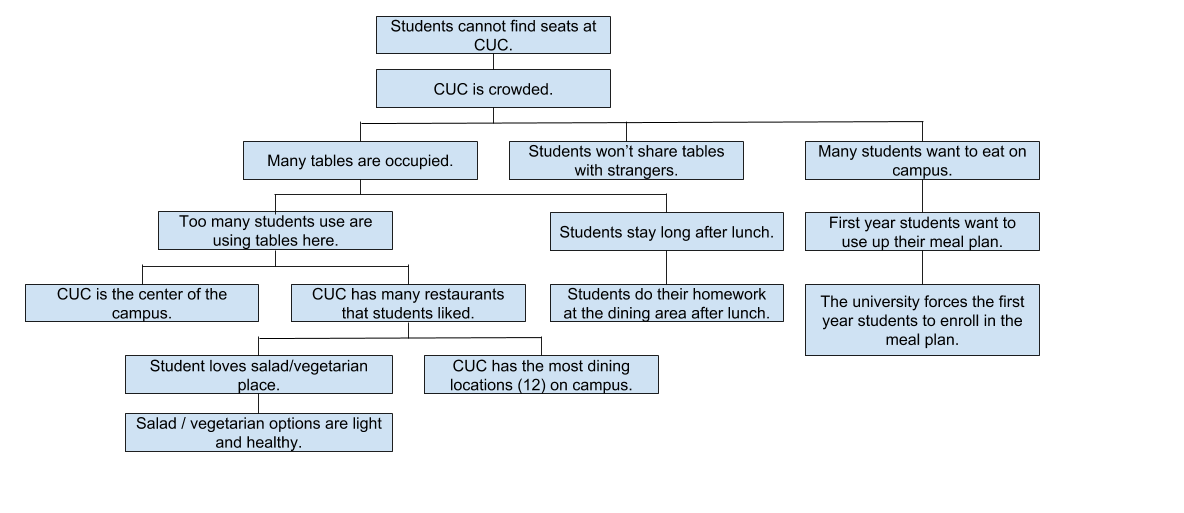Dining at Cohen University Center
Dining at Cohen University Center
January 2018
Typographically rearrange a given chunck of text into an internal report for a given client (Federal Aviation Agency).
Task
Identify a human factor problem, conduct user interviews, and redesign the environment to tackle the issue.
Background
Many students choose to lunch at Cohen University Center (CUC) of Carnegie Mellon University (CMU), resulting in the building to be very crowded, and the seats on high demand. The goal of this study is to identify why CUC is so crowded, and how we can redesign the system to help students who want to eat at CUC find their seats easily.
Methodology
Before jump right into the redesign of the system, I interviewed two students for user studies to help with the task analysis. After that, I composed a fault tree analysis for the root cause of this systematic problem, as well as the human factors involved. From there, I redesigned the system.
Problem Identified

Fault tree analysis: What is the root cause? Do some "symptoms" share the same root cause?
Gather all the leaves from the fault tree above, I found the following root causes that prevent students who want to eat at CUC to find a spot:
- The university forces the first year students to dine on-campus through the meal plan system.
- CUC has the most dining options across campus.
- Students are attracted by the healthy and lite food at CUC.
- CUC is located at the center of the campus, and is the most convenient place to go.
- Students may stay longer to finish their homework.
- Students are usually too timid to share their tables with the strangers.
Among the six root causes, I only considered three of them to be redesign-able. #1 is both good for the first year students to learn about the campus, and is also a very important financial income for the dining services. #2 is also not likely to get changed, because in general, the allocated dining location is not likely to change, or decrease. #4 is not likely to change, either. The CUC building won’t move. So I would like to focus on #3, #5 and #6.
Solutions
I would like to relief the crowdedness problem by focusing on #5 and #6. Specifically, I would like to add background noise and bar table at the second floor of CUC, to increase the turnover and the table usage.
Background Music
To shorten the time students spend sitting at the table doing their homework, we need to create an environment that is only suitable for eating and nothing more, so that students would finish their lunch as they normally would and leave, empty out the spot for the next student to use. I suggest adding some background noise during the peak time.
Specifically, the designer would like to add some background music to the dining environment during the peak time, starting from 11:00 to 2:00. Eating does not require much cognitive load; however, many other tasks, such as working on homework, remote video call, do require people to concentrate. Here, the background music would become a disturbance degrades speech understanding, and drives them away. Besides, this would work better if the musics are pop songs with lyrics. Due to the natural top-down processing, people would quickly pickup the lyrics, which occupies their mind, and increase the disturbances for non-eating tasks. Furthermore, studies have shown that loud and fast-paced music would significantly results in short stays, and faster turnovers.
The trade-off is that the staff at the dining area may suffer from hearing loss. The peak hour usually lasts for 2 hours. Then by OSHA’s standard, the sound level shall not go beyond 100 dBA. However, research has shown that for people under 30, the maximal sound level should be around 75 - 79 decibels, so the sound level should not be a huge problem.
Bar Table
Because of people’s natural tendency to “defend their private space”, many students find it awkward to share their table with strangers, or ask a stranger for table sharing. Typically, people would sit at a separate table, or, if people agree to do the table sharing to be polite, avoid eye-contact, or set up a boundary with readings or electronic devices.
The dining tables on the second floor of CUC where the dining area is located is usually filled with small round tables like this, with three chairs around it. Usually there are around one third of the students sitting by themselves (check the report appendix), which means, in this setting, wasting 2 seats all at once.
The designer hereby proposes that the university changes the small round to “bar tables” with tall chairs. Students will all be facing the lifted empty space to avoid the eye-gazing at each other, so that the violation of the private sphere no longer exists., and the threshold of table sharing will be easier. Furthermore, now that students can see the entire dining space instead of simply focusing on their little dining table, it extends their perception to the entire dining space. During the peak time, students would become more aware of the overly crowded dining area, which would drive them to leave.
The trade-off of table sharing, aside from the cost, is that unacquainted customers are put into a situation where there are plenty of opportunities to initiate a conversation, and thus elongates their time spent on dining.
Conclusion
After user studies and researches, I propose two solutions: the use of background music and the bar table, in order to speed up the table turnover, and invite the students for table sharing. The two methods should both be effective at a relatively low cost.
Check out more
Peer Economy in Emergency Response
Using peer economy to aid emergency response to natural disasters.